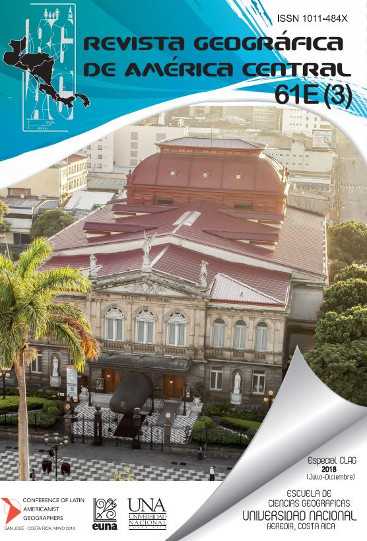New-hispanic cattle-ranching in the north of the Bishopric of Michoacan, 16th-17th centuries
DOI:
https://doi.org/10.15359/rgac.61-3.19Keywords:
Bishopric of Michoacan, animal husbandry, (ecclesiastic) land grants, tithe, H-GISAbstract
In this work we analyze the historical and geographical processes of animal husbandry in the north of the Bishopric of Michoacán through a cartographic analysis of the period from 1550, when the New Laws were applied, to 1650, just after the implementation of the Composición de Tierras (1643). Methodologically, we undertook analysis of historical documents, such as land grants for livestock raising (large- and small-scale) and bishopric reports, to process them and elaborate their cartography in a Geographic Information System oriented to historical analysis (Historical GIS). This allows us to spatially situate the establishment of cattle ranches. Although the granting of cattle licenses rested in the purview of the civil authority, the bishopric viewed this as a disruption of the territorial interests in jurisdictions under its ecclesiastical responsibility. Research such as this, that deals with history and historical cartography, are becoming increasingly relevant, as they address important lacunae in a historiography of the study region that has largely relegated the geographical perspective to the margins.
References
Acuña, R. (1987). Relaciones Geográficas del siglo XVI: Michoacán. México: Instituto de Investigaciones Antropológicas-UNAM.
Aguilar-Robledo, M. (2001). “Ganadería, tenencia de la tierra e impacto ambiental en la Huasteca Potosina: los años de la Colonia”. Historia ambiental de la ganadería en México. Xalapa, México: Instituto de Ecología, AC. (pp.9-24)
Aguilar-Robledo, M. (2009). “Contestred terrain: the rise and decline of surveying in New Spain, 1500-1800”. En Journal Latin American Geography, 8(2), 23-47.
Bakewell, P. (1976) Minería y sociedad en el México colonial. Zacatecas (1546-1700). México: Fondo de Cultura Económica.
Chevalier, F. (1976). La formación de los latifundios en México. México: Fondo de Cultura Económica.
Elías, F. (2014). La colonización ganadera en el Valle de los Chichimecas. La comarca y el desarrollo de una élite ganadera, 1540-1610. Guanajuato, México: Forum Cultural Guanajuato.
Guzmán, C. (2017). “Investigación histórica, los SIG y las nuevas posibilidades epistemológicas y metodológicas”. En Urquijo, P., Vieyra, A., Bocco, G. (2017). Geografía e Historia Ambiental. Morelia, México: Centro de Investigaciones en Geografía Ambiental-UNAM.
Hernández, L. (Compiladora) (2001). Historia ambiental de la ganadería en México. Xalapa, México: Instituto de Ecología.
Hunter, R. (2014). Land Use Change in New Spain: A Three-Dimensional Historical GIS Analysis. En: The Professional Geographer, 66(2), 260-273.
Instituto Nacional de Estadística Geografía e Informática. (1992). Topónimos por localidades.
Lemoine, E. (1993). Relación de la Diócesis de Michoacán hecha por el Obispo Fray Baltasar de Covarrubias en Valladolid en 1619, Versión Paleográfica. En Valladolid-Morelia 450 años. Documentos para su historia 1537-1828. Morelia, México: Morevallado Editores.
López, R. (ed.) (1973). Minuta y Rrazon de las doctrinas qye ay en este Obispado de Mechuacan assi beneficios de clerigos como gudarnias y prioratos de rreligiosos de San Francisco y San Agustin con los pueblos y feligreses que cada doctrina tiene. Versión Paleográfica. En El obispado de Michoacán en el siglo XVII. Informe inédito de beneficios, pueblos y lenguas. Morelia, México: FIMAX publicistas.
Melville, E. (1994). Plaga de ovejas: consecuencias ambientales en la conquista de México. México: Fondo de Cultura Económica.
Paredes, C. (ed.) (1994). Y por mi visto…mandamientos, ordenanzas, licencias y otras disposiciones virreinales sobre Michoacán en el siglo XVI. México: Universidad Michoacana de San Nicolás de Hidalgo/Centro de Investigaciones y Estudios Superiores en Antropología Social/Secretaría de Educación Pública.
Sheridan, C. (2015). Fronterización del espacio hacia el norte de la Nueva España. México: CIESAS/ Instituto Mora.
Sluyter, A. (1998). The ecological origns and consequences of cattle ranching in sixteenth-century New Spain. En: Geographical Review, 86(2), 161-77.
Sluyter, A. (2001). “Ganadería española y cambio ambiental en las tierras bajas de Veracruz, México, siglo XVI”. Historia ambiental de la ganadería en México. Xalapa, México: Instituto de Ecología, AC. (pp.25-40)
Y Sassy, A. (1982). “Demarcación y Descripción de El Obispado de Mechoacan y Fundación de su Iglesia Catedral. En Bibliotheca Americana, I(1). Florida, University of Miami Station, Coral Gables.
Downloads
Published
How to Cite
Issue
Section
License
Proposed policy for journals offering Open Access
Authors publishing their works in the Journal acknowledge and agree to the following terms:
a) Authors retain the copyrights to their works and guarantee the Journal the right to be the first to publish their works, under the Creative Commons License Attribution-NonCommercial-ShareAlike 4.0 International, CC BY-NC-SA 4.0 International (https://creativecommons.org/licenses/by-nc-sa/4.0/deed.es), which allows others to share works upon complying with the acknowledgment of authorship and mention of the Journal as the original publisher of the work.
b) Authors are permitted to separately establish additional agreements for the non-exclusive distribution of the official edition of the work published in the Journal (for example, authors may desire to place the work in an institutional repository or incorporate it into a book that is to published elsewhere) so long they acknowledgment to recognize the Journal as the original publisher. The aforementioned additional agreements must respect the terms of the non-profit character and sharing philosophy of the original license (CC BY-NC-SA 4.0 International, https://creativecommons.org/licenses/by-nc-sa/4.0/deed.es).
c) Authors are encouraged to archive the post-print or editor/PDF version in Open Access repositories.






 REVGEO is licensed under https://creativecommons.org/licenses/by-nc-sa/4.0/deed.es
REVGEO is licensed under https://creativecommons.org/licenses/by-nc-sa/4.0/deed.es
.svg_4.png)

_(1).png)
_(1)_(1)_(1)_1.png)
(2)(1)(1)(1).png)
